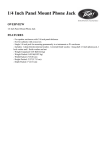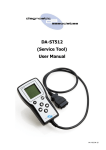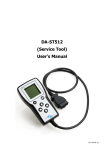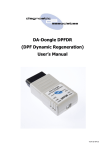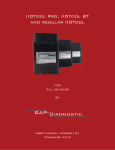Download Installing Split Front Door Speakers into an MY07 Subaru Forester
Transcript
This document is copyright © Adrian Broughton ([email protected]), 2007. Download this document from http://digitalkinetics.org/docs/forester_speakers.pdf Installing Split Front Door Speakers Into an MY07 Subaru Forester Introduction This article describes how I replaced the front door-mounted factory “split” speakers in my 2007 Forester XT with a set of aftermarket 6.5” split speakers. This article should be useful for all SG Foresters (2003 onwards). It is possible however that some minor trim details and dimensions have changed between 2003 and 2007. I say this because some people report requiring 25mm spacers to allow 2.75” deep woofers to fit cleanly while still allowing the window to wind up and down, while I only required 20mm spacers to allow my 3” deep woofers to fit. This discrepancy might be due to a number of factors (different speaker designs, etc), but be warned! Don’t take my word for anything, use common sense and measure everything up yourself. When the window winds down, it comes Figure 1 – The new split speakers installed in the doors appears identical to the Factory speakers. down very close to the back of the speaker. You may need to make thicker spacers in your case. I take no responsibility for any damage you do, nor do I make any claims about the accuracy of these instructions with regard to your vehicle. Hopefully this guide might help you, but If you break it (or anything else), don’t blame me! VERY IMPORTANT NOTE: If your car has side airbags then these will be located in the front seats. If you plan to install anything under one of the front seats (i.e. Amplifier, Stacker and/or crossovers) then you may need to remove the seat to allow room to work. Removing a front seat requires its airbag to be disconnected (the bright yellow connector under the seat). The following is a direct quote from a Subaru service manual: “When servicing a vehicle, be sure to turn the ignition switch to OFF, disconnect the ground cable from battery, and wait for more than 20 seconds before starting work. The airbag system is fitted with a backup power source. If the airbag system is serviced within 20 seconds after the ground cable is disconnected, it may inflate.” I strongly suggest taking heed of this warning. Having an airbag explode in your face is very dangerous. Not only would it leave you with a very sore face, but Figure 2 – The crossovers mounted on top of the amplifier also a sore wallet. under the front passenger seat location. READ THE WARNING BEFORE REMOVING A FRONT SEAT! Tools and Materials As far as tools go, you will need an assortment of flat and Philips-head screwdrivers, a clean rag, a 14mm socket and suitable ratchet and extension bar (if you plan to remove a front seat), a pair of wire cutters and strippers, a drill, a jigsaw, a rotary tool (commonly referred to as a “Dremel”) with a cylindrical sanding attachment and small grinding attachment, and a long stiff piece of wire or a narrow rod such as a straightened-out coat-hanger or an old dipstick. Other household tools like a knife and pliers are also handy. The materials you will need include a sheet of 5mm MDF board (at least 40cm x 20cm), a pair of 6.5” x 15mm MDF speaker spacer rings from your local Figure 3 – My aftermarket 6.5” woofer, 1” tweeter, and car audio shop (or a sheet of 15mm MDF to make crossover across the top row, and stock tweeter and your own rings, at least 40cm x 20cm), some woofer below on the bottom row. contact cement, speaker wire, and a can of cheap spray-paint (colour doesn’t matter, but I used matt black). The amount of speaker wire depends on whether you intend to re-use any of the existing factory speaker wire, and where you intend to install your Crossovers and Amplifier. I purchased about 15m of oxygen-free speaker wire from Dick Smith (at about AU$1.55/m) which has a considerably thicker core than the thin wire supplied with the New Speakers, yet isn’t so thick that it’s expensive or difficult to work with. I don’t want to start a debate on the merits of various speaker wires though, so you choose whatever you feel happy with. I found 15m to be just about the right total length of wire for my install, but it’s worth being careful before cutting it (i.e. don’t just cut it into 4 equal lengths, remember that the wiring will likely be longer on one side of the car than the other and measure first). If you plan to install an Amplifier and Crossovers in a similar manner to me (on the floor under one of the front seats) then you might also find some self-adhesive strips of Velcro handy to stick to the bottom of the Amplifier as a very simply means of securing it to the carpet under the seat (the Velcro stops it sliding around the floor). I also use Velcro to secure the Crossovers to the top of the Amplifier (see Fig 2 to illustrate the arrangement). Obviously you will also need some speakers and crossovers of some kind. I chose a modest set of Response 6.5” Kevlar Splits (sold by Jaycar in Australia), which come as a kit including 6.5” woofers, 1” tweeters, external crossovers, and some mounting hardware. I chose to mount the crossovers in the cabin of the car (opposed to mounting them in the doors) as this keeps them away from any water that might leak into the doors when the window is open and allows for easy Figure 4 – Compare the size of the magnet in the Factory Woofer (left) and New Woofer (right). The Factory Woofer sounded surprisingly good considering how puny it looks, but was still no comparison to the New Woofer. access. There is plenty of room under the passenger seat for them to sit on top of an Amp I was installing there at the same time (the crossovers can even be raised a bit above the Amp to allow for more airflow around the Amp if necessary). If you choose to install the crossovers in the doors rather than the cabin, you can make use of most of the factory speaker wiring and save yourself the hassle of threading new speaker wire through the door into the cabin (and it then requires much less speaker wire), but I didn’t want to cut up the factory wiring and wanted to keep the crossovers in the cabin so I chose to install new speaker wire and leave the factory wire alone. Another good mounting location for the Crossovers may also be the kick panels. Step 1 – Removing the Factory Tweeters The factory tweeters are contained in small self-contained housings on the inside of the front doors just near the side mirrors. The whole assembly can be easily removed from the door by gently levering a large screwdriver between the housing and the rubber on the door behind it to prise the assembly away. Wrap the screwdriver in a rag if you are worried about scratching anything. You can then prise the grey mounting bracket away from the black housing in a similar manner carefully with a screwdriver, and then easily unplug the tweeter from the wiring coming from the door. Figure 5 – The factory tweeter assembly consists of three parts; the tweeter itself, the grey mounting bracket, and the black housing. Finally, you can remove the Tweeter from its grey mounting bracket by unscrewing the screw and gently prising it away with a smaller screwdriver (it is glued as well as screwed down). We won’t need the Factory Tweeter any more, but we will need to modify the grey mounting bracket to later accommodate the new Tweeter and then mount it back into the black housing ready to put back on the door. But we have a few more things to do before we go putting this stuff together and back into the car, so keep reading. Step 2 – Removing the Factory Woofers The Factory Woofer speakers are located at the bottom of the doors. They are fairly easy to get to, but require the door skins to be removed first. Before you remove the door skin, you must remove the Tweeter housing from the door (see step 1). Assuming you have the tweeter housing removed, below are the steps for removing the door skin: 1. Use a flat-blade screwdriver to remove Figure 6 – Steps to removing the door skin. Match the numbers to the steps on the left. the little cover inside the door handle surround (marked #1 in Fig 6), and then remove the Philips-head screw behind the cover. Then carefully using a flat-blade screwdriver wrapped in a rag (so as not to scratch the plastic), prise the door handle surround off the door skin (each clip should snap out with care). 2. Remove another little screw-cover inside the arm rest recess (marked #2 in Fig 6) and then use a large Philips-head screwdriver to remove the large screw underneath. Figure 7 – This photo of the underside of the door skin shows the clips you need to pop off (and the suggested 3. Using a large flat-blade screwdriver order you should do it in). wrapped in a rag, very carefully lever the plastic door control panel upwards at the two points indicated (that’s where the press-in clips are located). Be particularly careful about the middle point as that is also where two parts of the plastic are joined and so is a bit fragile. The metal clips might fall off as you lift the panel, but as long as you don’t lose them you can easily put them back in place. 4. Using a large flat-blade screwdriver wrapped in a rag, gently lever the door skin away from the door starting at the location marked #4 in Fig 6 and working down and across. There are nine press-in clips behind the trim that should “pop” off as you go. This process can be a bit daunting the first time you do it, but be patient and careful and don’t force anything too hard. Refer to Fig 7 for the suggested order you should tackle the clips in. 5. Once you have the door skin unclipped, you should be able to simply lift the door Figure 8 – With the door skin removed, the Factory skin up and out and the top lip should lift Woofer can now be easily accessed. out of window slot at the top of the door. Now that you have the door skin removed you have easy access to the Factory Woofer. Simply disconnect the speaker wire connector and unscrew the three screws securing the Woofer in place. Step 3 – Installing the Speaker Wire This was the most frustrating part of the whole installation. The idea is simple, but threading the new speaker wire through the rubber conduits that run wires from the door cavity into the cabin is a fiddly and awkward job. Before you go chopping up speaker wire, just sit back and think about where you will be mounting your Crossovers and Amplifier. If you decide to locate these things under the passenger seat as I did, then do a “dry run” with the seat in place and make sure it all fits nicely (and you can still adjust the seat forwards and back without fouling anything). Then have a think about how long the wires will need to be to thread through the doors and go where you want them to. Remember that if you are installing Splits then you’ll need to run two lots of speaker wire from the doors to the Crossovers, and then one speaker wire from the Crossover to the Amplifier. When you open a front door and look at the gap between the door and cabin near the hinges, you’ll notice a rubber conduit that runs between the door and cabin. All the wiring in the door controlling locks, window controls, and factory speaker wire runs through this conduit. We want our new speaker wire to run through it too. Figure 9 – Think carefully where the wire needs to run to before cutting anything. You will also need to remove pieces of trim to get the wire running under carpet and so on. At either end of the conduit, where it passes through the sheet metal of the door and the body, you’ll notice it expands out to form a rubber grommet that holds the conduit in place. Open the door and remove the piece of trim that covers the bottom of the door sill (in an MY07 Forester is has a metal plate with “Forester” stamped on it). There will be a couple of plastic trim clips in the foot-well (one of them screws off), and a few snap-in clips holding the trim to the door sill (use the trusty flat-blade screwdriver in a rag). Once you have the door sill trim removed, you’ll notice a fairly large electrical connector just inside the cabin, close to where the conduit passes from cabin to door behind the kick panel (near where the woofer is when the door is closed). The bundle of wires coming off this connector should lead through the conduit going to the door. Unplug this connector. Now you should feed the connector and its cable from inside the cabin through the hole in the body Figure 10 – Feed the connector and loom from the cabin into the door to gain access to it, and then feed the new and then through the hole in the door. To do this Speaker Wire through the conduit. you’ll need to pop the conduit grommets off both of these holes (popping them towards the inside of the door), and feed the whole conduit and cable into the door cavity and then out into the open. The end result is pictured in Fig 10. Now you have easy access to the conduit, you can feed your new Speaker Wire through it. Before you do this, remove some of the electrical tape at each end of the conduit so you can poke something through it. Now, grab your coat-hanger wire (or old dipstick, or any old stiff wire or thin rod) and using a bit of electrical tape, attach the end of the speaker wire(s) to the end of the rod and poke the rod through the conduit until the end (and the speaker wire) appear at the other end. You can then remove the electrical tape, remove the rod, and then pull the speaker wire through. If you find it difficult to poke the wire through the rubber conduit and find it “grips” on the plastic wire, try rubbing a small amount of oil on the wire and rod to lubricate it. I use a very light hit of spray-on cooking oil for things like this which works well. Once you have the speaker wire threaded through the conduit, you need to feed the whole thing back through the holes in the door and then into the body and re-attach the grommets and get it all back the way it was. This will require some patience and probably much cursing. A large blunt screwdriver wrapped in a rag might also help poke and prod the grommet into place, but be very careful not to scratch the paint. Once the conduit is back in place, make sure the new Speaker Wires reach where they need to, and label the Tweeter and Woofer wires appropriately. Step 4 – Installing the New Woofers This is the part of the install where you have to brush off your woodworking skills and actually create something. But don’t worry, what we’re building is simple to make it doesn’t matter what the end result looks like because it will all be hidden behind the door skin. You should be staring at a door with the door skin and Factory Woofer removed, with some new speaker wire already passing through into the door Figure 11 – Wind down the window so you can see how much depth you have available for the New Woofer. ready to connect up to the New Woofer. At this stage I’d suggest keeping the window wound down completely on the door you are working with (you will need to re-connect the window controls on both doors to do this). That way you can easily tell just how much depth you have to work with (the window winds down past the speaker). Take your new woofer and place it in the speaker hole to get a rough idea how far out it needs to be mounted in order to remain clear of the window behind it. The mounting spacer we need to make for each woofer consists of two parts which will be joined together. The spacer performs three functions; it reduces the depth the woofer requires inside the door (which is necessary otherwise the window will hit the speaker’s magnet when it gets wound down), and it allows the speaker to be mounted as a direct replacement for the Factory Woofer (you re-use the same mounting screws and screwholes), and it locates the speaker correctly in the door skin. Note that although we need to use Figure 12 – Measure the depth of your New Woofer to spacers to reduce the depth of the speaker inside get an idea of how much depth you need in the door. If your Woofers are more than 75mm thick then you will the door, we don’t want to make the spacers any probably need to make thicker spacers than those larger than we need to. Remember that the door shown here. skin needs to go over the top of the speakers, and thick spacers will probably require modifications to the door skin or longer clips in the door skins to put it back together. The MDF thicknesses I provide for the templates (5mm for Template #1 and 15mm for #2) will produce 20mm spacers which allowed just enough room to fit Woofers that are 75mm deep. Making the spacers should be fairly straightforward as long as you have appropriate tools and know how to use them. I’d strongly suggest making Spacers for both doors at the same time which means making two of everything shown here. Simply print out the templates provided at the end of this guide (make sure they are printed at their correct sizes), then stick them onto some appropriate MDF board and use a Jigsaw to cut around them. I used commerciallyavailable spacer rings instead of 15mm MDF for Template #2 (15mm 6.5” MDF rings purchased from Figure 13 – The two pieces of MDF join together and mount to both the New Woofer and the original mounting JB Hi-Fi) and then just cut three small semi-circles out points in the door. of them with a drill and a Dremel. The end result can be seen in Fig 13. But before gluing and screwing the two pieces of MDF together permanently, do a test-run and place them together with the Woofer in the door to make sure they do provide enough clearance. You may need to use thicker spacers. Once you are happy, glue/screw them together securely. Now (with the spacer out of the car) place your New Woofer into the Spacer and drill any necessary screw holes for mounting the two things together. Once done, remove the Woofer again. The final step before installing a Spacer is to paint it. Because MDF board acts like a sponge and swells and goes soft when exposed to water, it’s a very good idea to try to seal the MDF by painting it. I just bought a can of $2 matt black spray paint and applied it liberally. The spacers won’t be visible once the door trim is back on, so colour and neatness isn’t really important – the idea is just to provide a barrier against moisture. Once you are done and the paint is dry, you can Figure 14 – With the spacer painted, it and the New Woofer can be mounted to the door. mount the Spacer to the door using the screws that originally held in the Factory Woofer. Once the spacer is mounted then you can mount the speaker to the spacer. Work out the best route for the speaker wire to get to the New Woofer, keeping in mind that there will be a window moving up and down close behind the speaker. Once you’ve got the New Woofer mounted, hooked up, and tested (including checking to ensure the window winds up and down fully), you can replace the Door Skin using the reverse procedure of the removal (see Step 2). Step 5 – Installing the New Tweeters Now that we have the wiring in place and the door skin back on, we can install the new Tweeters and hook them up. Assuming your new Tweeters are roughly the same size as the Factory Tweeters (approx 1”), it should be fairly straightforward getting them to fit. The only modification I needed to make was to use my Dremel (rotary tool) with a grinding attachment on the grey Mounting bracket to allow my new Tweeter to sit flush the way the Factory Tweeter did (see Fig 15). I then simply glued the new Tweeter to the bracket using contact cement. Finally, the whole enclosure simply snaps back together and back into place in the reverse procedure of Step 1 (removing the Factory Tweeters). Figure 15 – The original Tweeter mounting bracket (left) and the modified bracket (right). Final Thoughts Installing the door speakers and wire is of course only part of the job of upgrading the audio equipment in your Forester. You’ll probably also be installing Crossovers for the speakers and an Amplifier at the same time as doing these speakers. You may also be installing a Subwoofer and new Head Unit as well. The installation of all of these things is beyond the scope of this document, but there are plenty of other resources floating around the internet to help. Appendix A – Woofer Templates Important Note: When printing these templates from a PDF file, make sure that in the Print Dialog Window the “Scaling” drop-down option is set to “None” otherwise the templates will not be printed at their correct size.










